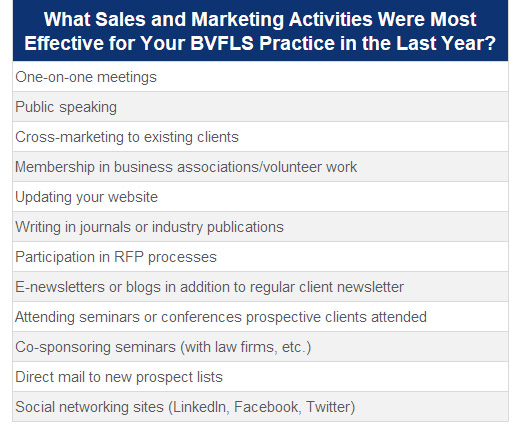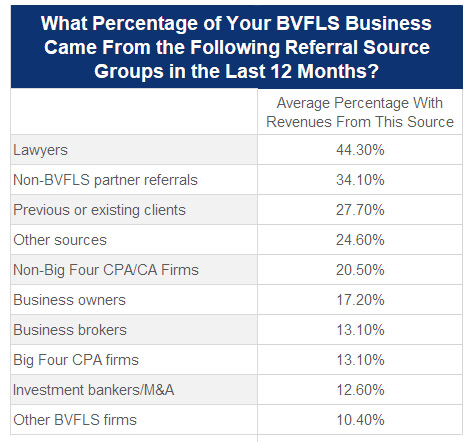New survey uncovers the most effective ways to get more business valuation clients
Over 160 business valuation, forensic, and litigation support (BVFLS) firms responded to BVR’s survey conducted in late 2018 on their best practices in financial management, marketing, human resources, compensation, and professional and ownership standards. While respondents said they use many different marketing techniques, the one-on-one meeting with prospective clients continues to be the best way to bring in valuation business. Keep reading to learn more about other commonly used techniques, what is working, and who the best prospects are for the business valuation professional.
What marketing technique is used most?
Three of the five marketing techniques that are most prevalent involve face-to-face interaction with prospects or referral sources. These techniques are:
- One-on-one meetings with prospective clients (cited by 58% of survey respondents);
- Public speaking (44%); and
- Joining business organizations such as associations, committees, and boards (37%).
Rounding out the top five are: cross-marketing to existing clients (40%) and updating the marketing website (36%).
Some other techniques commonly used include:
- Writing in journals or industry publications;
- Attending seminars or conferences prospective clients attend;
- E-newsletters or blogs in addition to regular client newsletter;
- Co-sponsoring seminars (with law firms, etc.);
- Social networking (LinkedIn, Twitter, Facebook, etc.);
- Emails to new prospect lists;
- Sending press or public relations materials;
- Participation in RFP processes;
- Direct mail to new prospect lists;
- Financial expert directories; and
- Advertising in professional journals or other publications.
What works best?
Prevalence of techniques is revealing, but the important question is: What really works? The responses were quite interesting. The editors of the survey have done some culling and analysis to identify the most effective marketing and sales activities respondents mentioned, in approximate descending order, in the chart below. Over 124 firms in the survey answered this question.

Based on the responses, the “most effective” marketing technique was one-on-one meetings, followed closely by public speaking.
Keep in mind that only a small minority of firms often use some of the less frequently mentioned “most effective” items, so don’t dismiss a technique because it wasn’t mentioned near the top. Someone, at some firm, is making each of these techniques work to bring in new business.
Who are your best prospects?
Firms with business from lawyers get over 44% of their BVFLS revenue from this source, as shown in the chart below. In fact, 40% of all firms in the survey received more than half of their work from this source. Still, only 5% of firms in the entire survey database (116 firms answered this question) depend on one client group only, proving that BVFLS client development is a complicated activity. Lawyers are the top market, for sure, but no one is dependent on legal referrals alone.

Non-BVFLS partner referrals and previous or existing client referrals are the other major sources of engagements. CPA firms with BVFLS practices have an advantage here: They are twice as likely to receive new work from client referrals as BVFLS-only firms are, likely because they already have the trust of their tax and audit clients.
Many BVFLS firms have become quite savvy at marketing to lawyers. There may be an opportunity for some firms to expand their marketing efforts toward the “secondary” market groups, however. This is particularly true for BVFLS partners at CPA firms; they tend to be more reliant on referrals from their CPA partners—and lawyers—and less attentive to other potential sources of business.
CPA firms—”Big Four” or otherwise—business brokers, investment bankers, and the M&A world are also smaller but dependable sources of business for some firms.
Conclusion
To benchmark your firm’s performance and see how it stacks up against others across the U.S., check out BVR’s survey and analysis in the BVR Firm Economics & Best Practices Guide, 2019-2020 edition. This resource presents best practices in financial management, marketing, human resources, compensation, and professional and ownership standards. Data on over 330 BVFLS firm owners/partners and over 1,200 professional staff are included in the management and compensation sections so you’ll have the most current insights to help you enhance your practice and plan for future growth.
